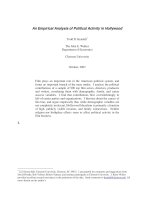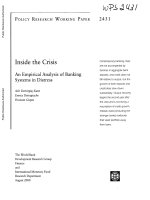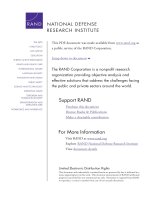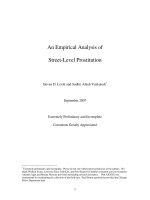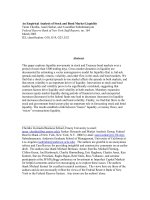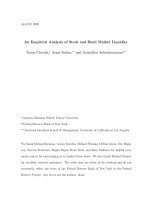The impact of development on the export quality of a country an empirical analysis of chinese imports
Bạn đang xem bản rút gọn của tài liệu. Xem và tải ngay bản đầy đủ của tài liệu tại đây (345.66 KB, 30 trang )
The Impact of Development on Export Quality of a Country:
An empirical analysis of Chinese imports1
Chandrani Sarma
(M.Soc.Sci in Economics), NUS
A Thesis submitted for the degree of
Master’s in Economics
Department of Economics
National University of Singapore, 2012
1
Acknowledgement: I greatly appreciate the help and guidance I received from my supervisor Prof Lu Yi
2
ABSTRACT
This paper mainly tries to estimate the quality of imported goods in the Chinese market using
raw import data, along a model constructed by Amit Khandelwal (2008) based on the logit
framework established by Berry (1994). Since product quality is unobserved; there are no
uniform records of quality across products, countries and years; a major impediment to
research in this area. Hence, unit price has been used by researchers as a proxy; a measure
inappropriate if the product has vertical and horizontal attributes. This model estimates
product quality based on a more accurate measure, incorporating both price and market share
for 178 countries within each 4-digit industry of the manufacturing industries; and then to
further use this estimated quality to establish its positive relation with GDP per capita of the
exporting country, i.e., developed countries are more likely to consume and export higher
quality goods than developing countries.
3
1. INTRODUCTION
Quality of exported goods has been of utmost relevance to economists and decision makers
globally. Quality of manufactured products in a country affects many economic outcomes
within that country. A substantial amount of theoretical work predicts that quality
systematically affects the direction of international trade. Linder (1961) was the first to note
the role of quality as a determinant of the direction of trade, placing it at centre stage.
Increasing evidence indicates that there are large differences across countries in the quality of
the products that they produce and export. On the production side, better technology and
skilled labor are strongly correlated with a countries’ income per capita, suggesting a positive
relationship between per-capita income and quality production. On the consumption side,
household data shows that quality demanded is strongly correlated with household income,
suggesting that, on the aggregate, high income countries consume and export larger
proportions of high quality goods 2. This systematic supply-side and demand-side relationship
between income per capita and product quality indicate a potentially important role of
product quality as a determinant of bilateral trade patterns. Hence, on an average, richer
countries trade more intensely with one another.
As empirical results confirm the theoretical prediction that rich countries tend to import
relatively more from countries that produce high quality goods [Hallak (2006), Schott(2004)],
it is seen as an important condition for developing countries to transition from manufacturing
low-quality to high-quality goods for export success and hence for economic development.
These past works on estimation and debate on quality, stress on its high importance. Various
market characteristics can be inferred from this indicator; income inequality, cross-border
2
Hallak (2006), Schott (2004), Hummels and Klenow (2005), Bils and Klenow (2001)
4
trade, trade tariffs and even economic growth. This interaction is also a subject of interest in
policy-oriented research. However, product quality is one that is highly subjective and
unobserved. There is no uniform record of quality across products, countries, industries and
years, which is a major roadblock for research in this field. This problem has most often been
dealt with researchers by constructing proxies for quality. The most common proxy is the
observed export prices of products; the obvious advantage being that it’s easily available.
However, this measure is unsatisfactory because export prices may vary for reasons other
than quality.
First, it may reflect variation in manufacturing costs. For e.g. in 2001, Chinese imports of
farm tools from Luxembourg and Mexico were priced at about $20704 and $291 unit price,
respectively. Now, if prices are perfect proxies for quality, Luxembourg’s tools have roughly
70 times greater quality than Mexican trousers. However, difference in factor prices has not
been taken into account here. The annual wage in the manufacturing industry in that year for
Luxembourg and Mexico were $41000 and $1800. Therefore, it is cheaper to employ labour
in Mexico to manufacture that same product than in Luxembourg which reflects in the price,
and cannot be a sure measure of the quality of the two goods.
Second, if consumers’ value of variety and goods are horizontally (color, shape, cut, location)
besides being vertically differentiated, prices can undermine the quality perceived by
consumers. For e.g. say there are two different branded identical shirts with identical prices,
one blue and the other red. If a consumer prefers red, he would associate a higher quality with
that shirt, despite the fact that both the shirts are equally priced. This heterogeneity illustrates
the shortcoming in invoking the quality-equals-price assumption, suggesting that expensive
imports can co-exist with cheaper rivals as a result of horizontal product differentiation.
5
Thirdly, Chinese shirts might be cheapest in the international market because of lower
quality, but they might also sell at a discount because China has lower production costs or an
undervalued exchange rate. Hence, these examples show that there is need for a better and
more suitable method of estimating the true perceived quality by consumers in a market
which doesn’t only reflect the price but takes into account other factors that influence
consumer’s perception of product quality.
Such a method was designed and tested by Amit Khandelwal in his paper (2008), titled the
‘Long and Short (of) Quality Ladders’, based on a framework established by Berry (1994). In
his paper, he uses the import data for the United States to establish the relation between
product quality and exporting country’s GDP per capita. The procedure utilises both unit
value and quantity information to infer quality and has a very straightforward intuition:
conditional on price, imports with higher market share are assigned higher quality by
consumers. Suppose Germany and China manufacture the exact same shirt, but the German
shirt costs more to produce because of more expensive raw materials and labour cost. The
objective quality is the same. If quality were measured only by price, the German shirt would
sit higher on a quality scale. Now, suppose you price the German shirt and the Chinese shirt
the same. Higher quality should be assigned in this scenario to the shirt that achieves a higher
market share.
In this paper, I use Chinese import data to follow a similar path to establishing the results.
China's top five importing countries or regions are Japan, EU, ASEAN, South Korea, and
Taiwan and its top importing provinces are Guangdong, Jiangsu and Beijing. Its
Manufacturing Industry currently ranks 4th in the world and forms the backbone of the
economy of China. The productivity of China's manufacturing industry was 35.30% of the
6
gross domestic product and approximately 78.68% pertaining to all other industries in the
year 2003. United States of America ranks first, followed by Japan and Germany. In this
paper, using the alternative method, I take the cross-sectional import data from 178 countries
for the Chinese market pertaining to the manufacturing industry for each 6-digit HS product
to establish the positive correlation between income per capita of a country and its export
quality, i.e., more advanced countries manufacture higher quality products.
Having estimated the qualities of the imported products, I further show situations where
price-equals-quality assumption is unsuitable by using a term called “quality ladder length”,
for each 6-digit HS product as the difference between the best and worst import qualities.
Section 2 discusses the literature review in this field. Section 3 explains the theoretical
framework, followed by the data description. Section 4 shows the results of the quality
estimation and its relation to GDP per capita and quality ladder. Section 5 deals with
robustness checks and Section 6 concludes. Two appendices attached to this paper provide
the names of the countries that were considered in this paper and a detailed mathematical
explanation of the terms in the regression equations.
7
2. LITERATURE REVIEW
Theoretical and empirical research increasingly point to the importance of product quality in
international trade and economic development. Linder, in his paper in 1961, argued that
richer countries spend a larger proportion of their income on high quality goods. He also
argued that closeness to demand is a source of comparative advantage (productivity, factor
endowment), providing richer countries with a comparative advantage in the production of
high quality goods– the goods that they demand. He then infers that the congruence of
production and consumption patterns lead countries with similar income per capita to trade
more with one another. The Linder hypothesis attracted the attention of scholars for decades
due to its sharp contrast with the predictions of the Heckscher-Ohlin (or factor proportions)
theory — the usual benchmark for most empirical work on determinants of trade patterns and
effects of trade policies — which suggests more intense trade between countries of dissimilar
income per capita, a prediction commonly known as “the Linder hypothesis”. 3
Flam and Helpman (1987) is representative of a line of theoretical research studying the
influence of product quality on international trade. Hallak (2006) and Schott (2004)
conducted empirical research to prove Linder’s hypothesis. Empirically, product quality was
linked to a firm’s export success in the papers by Brooks (2006), Verhoogen (2008).
Verhoogen (2008) also linked quality with wage inequality establishing that quality
upgrading leads to increase in income inequality. Quantitative import restrictions’ link with
product quality was discussed in detail in papers by Aw and Roberts (1986) and Feenstra
(1988). The contribution of quality growth to macroeconomic growth is investigated
3
Schott, 2004
8
theoretically by Grossman and Helpman (1991) and empirically by Hummels and Klenow
(2005).
Hence, to establish correlation of quality with various economic outcomes, researchers have
often constructed ad hoc proxies for quality, the most common of which is observed export
prices (unit values). It is often used to distinguish horizontal from vertical intra-industry trade
flows (e.g., Abed-el-Rahman 1991 and Aiginger 1997). An examination of US import data in
the paper Khandelwal (2008) reveals that vertical specialization is more pronounced in
markets than horizontal characteristics. In the paper Schott (2004), he finds that high-income
countries inhabit the upper rungs of the quality ladder in most products, using unit values as
proxy for quality.
Horizontal and Vertical Differentiation
Horizontally differentiated products vary only marginally, as it's more efficient for producers
to try to capture as many new consumers as possible with minimal additional costs. It is often
is cheaper than improving quality, which is necessary for vertical differentiation. While
horizontally differentiated products tend to command similar prices at equilibrium, the lack
of relationship to quality does not necessarily imply that they cost the same -- two products
may be virtually identical in all considerations except for colour or flavour and still be
offered at totally different prices. Common examples of horizontal differentiation include
location -- offering the same products, but in different geographical areas -- or colour.
Horizontal differentiation offers producers some key advantages, including the possibility of
greater market share -- for example, refrigerators offered in both white and black appeals to
consumers with either preference. However, it is not enough to acquire new customers if they
are looking for higher levels of objectively measured quality or lower prices.
9
Vertical differentiation occurs in a market where the several goods that are present can be
ordered according to their objective quality from the highest to the lowest. It's possible to say
in this case that one good is "better" than another. Vertical differentiation is a property of the
supplied goods but, as it is maybe needless to say, the perceived difference in quality by
different consumer will play a crucial role in the purchase decisions. When products are
distinguished by a vertical characteristic, those products with higher values of that
characteristic will command higher prices. However, certain complex markets are
characterised both by horizontal and vertical differentiation. For instance, apparel, garments
and shoes have an amazingly rich combination of shapes, colours, materials,
complementarities, seasonal and territorial specificities, appropriateness to social events,
relative distance to ideals promoted by media, stylists and the show business. The presence of
purely horizontal components distorts the relation between price and quality.
Hence, the method developed by Amit Khandelwal (2008) is very useful is estimating quality
of goods correctly incorporating both prices and market share information that accounts for
both vertical and horizontal differentiation (See theoretical framework).
He also introduced the concept of quality ladders from the estimated qualities as the
difference between the maximum and minimum quality within a product:
For the US market, he shows that in markets characterized by long quality ladders, prices can
be considered as suitable proxies for quality. But that this correlation weakens as the ladder
length declines in short-ladder markets. So a consumer, on an average, may not attach a high
valuation to expensive imported goods in short-ladder market. Hence, this method suggests
10
that the scope for quality differentiation varies substantially across products. Hence, even
with large variation in prices, products may possess little differentiation in quality.
He goes on to show in this paper, using ladder lengths that quality specialization has
important implications for the US labor market. The public’s fear of globalization is often
rooted in the vulnerability of contestable jobs. The findings are consistent with Bernard,
Jensen and Schott (2006) that industry employment is negatively associated with the import
penetration, especially from low-wage countries. He finds that in long-ladder markets,
developed countries can insulate themselves from low-wage countries by using comparative
advantage factors (e.g. skill, capital or technology) to specialize atop the quality ladder. In
short ladder markets, however, developed countries will be directly exposed to Southern
competition because quality upgrading is infeasible. 4
Once quality of goods has been calculated correctly, it can offer insights into other theories
related to international trade, economic development and industrial organization:
•
Amiti and Khandelwal paper (2009) uses the quality measures to show that the
relationship between a country’s pattern of quality upgrading and its level of domestic
competition depends on the country’s distance to the world quality frontier. The
analysis is based on recent theoretical frameworks that predict that the effect of
competition on innovation depends on firms’ proximity to the world technological
frontier. They find that lower tariffs are associated with quality upgrading for
products close to the world frontier; whereas lower tariffs discourage quality
upgrading for varieties distant from the frontier. This is consistent with the theory
developed by Aghion et. al (2009).
4
Khandelwal (2008)
11
•
Chari and Khandelwal paper (2009) uses these quality estimates to provide evidence
that quality specialization also plays a role in determining rates of protection across
industries. They find that industries with relatively short quality ladders are associated
with larger tariffs as well as larger subsequent increases in rates of tariff. Also,
increased specialization, in the sense that the ladder is lengthening, is associated with
lower tariff increases. These results suggest a previously unconsidered mechanism by
which the technology of innovation and international trade interact to determine trade
policy.
While a lot of research has been done in establishing correlations of economic outcomes with
quality, relatively little is known about how countries’ product quality varies across time, or
how it is influenced by trade liberalization and other aspects of globalization. This remains to
be done in future work.
12
3.1 THE THEORETICAL FRAMEWORK 5
This section describes the procedure that uses both price and quantity information to estimate
quality of a good, based on the intuition that conditional on price, higher quality is assigned
to products with higher market shares. The methodology is based on the nested logit
framework by Berry (1994). The ingenuity of this model is that it requires data that is very
readily available across all industries.
Each product within an industry is denoted by an h. An import from country c within a
product h is called a variety (ch). The consumer preferences are modeled for a single
industry; hence the industry subscript is suppressed. According to the model, consumer n has
preferences for product h exported by country c (e.g. variety ch) at time t. The consumer
consumes the variety that gives him the highest level of indirect utility:
Vncht= λ 1, ch + λ 2, t + λ 3, cht − α pcht + ∑ h =1 µ nhtdch + (1 − σ ) ∈ ncht
H
(1)
From this, quality is defined as:
λ 1, ch + λ 2, t + λ 3, cht
(2)
This term reflects the valuation of variety ch that is common across consumers. This quality
term is decomposed into 3 components. The first term,
, is the time-invariant valuation
that the consumer attaches to variety ch (the variety-fixed effects). The second term,
,
controls for the secular time trends common across all varieties (the year-fixed effects). The
term,
, in the estimation error, the variety-time deviation from the fixed-effect that the
consumers observe but we, econometricians, don’t.
5
The model is taken from “The long and Short (of) quality ladders” Khandelwal (2008)
13
The term
is assumed to be distributed Type-I extreme value and explains consumer
behavior why a low-quality variety which is expensive is ever purchased. The term
depicts the common valuation that consumer n places on all varieties within product h, while
is a dummy variable that takes the value 1 when a country c’s export lies in product h.
This nested logit captures the preference structure, for e.g., a consumer who prefers Japanese
wool shirts is more likely to prefer other wool shirts rather than cotton shirts.
An ‘outside’ variety (domestically produced within the country) completes the demand
system. The purpose of the outside variety is to allow consumers the possibility not to
purchase any imported goods. Since, consumers may choose to purchase a domestic variety
(or simply not buy any) if the price of all imports rise. The utility of the outside variety is
given as:
un 0t= λ 1, 0 + λ 2, t + λ 3, 0t − α p 0t + µ n 0t + (1 − σ ) ∈ n 0t
(3)
The mean utility of the outside variety is normalized to zero; this anchors the valuations of
the inside varieties. In this context, the outside variety can be thought of as the domestic
substitutes for imports and therefore set the outside variety market share to 1 minus the
industry’s import penetration. Once the outside variety market share (
) is known 6, the
total industry output MKT (Domestic Output – Export + Import) can be computed from the
import data available.
Under the distributional assumptions for the random component of consumer utility, Berry
(1994) has shown that the demand curve implied by the preferences in (1) is:
6
Information on the outside market share (including export share) was gathered from the official Chinese
website chinadataonline.com
14
ln( scht ) − ln( s 0t ) = λ 1, ch + λ 2, t + α pcht + σ ln(nscht ) + λ 3, cht
Where
is variety ch’s overall market share and
(4)
is its market share within
product h. A detailed calculation of all the terms is shown in Appendix B.
Identification and hidden varieties
In estimating (4), a problem of unobserved of ‘hidden’ varieties may arise. To understand
how hidden varieties could confound the measurement of quality, suppose that Brazil and
India export identical varieties at identical prices and split the market equally at the
(unobserved) 6-digit level, but that Brazil exports more 6-digit varieties (such as more
colours) than India. Aggregation to the observed 4-digit level would assign a larger market
share at identical prices to Brazil. From (4), Brazil’s estimated quality would be higher
because of the hidden varieties. Hence, the demand curve needs to be adjusted for the hidden
varieties, and is given by equation (5):
ln( scht ) − ln( s 0t ) = λ 1, ch + λ 2, t + α pcht + σ ln(nscht ) + γ ln( popct ) + λ 3, cht
This is followed from Krugman (1980) and others that use a country’s population as a proxy
for a countries hidden varieties; where
is the population of country c, saying that
number of varieties produced is increasing in a country’s population. This equation is used
for each industry to estimate quality of the imported goods from each country.
The quality of variety ch at time t is defined using the estimated parameters:
(6)
15
From equation (6), we see that the quality of an imported variety is defined relative to its
market share after controlling for exporter size and price. More generally, this notion allows a
variety’s price to rise without it losing market share. Though many factors unrelated to
quality could affect market shares and therefore confound our measure of quality, these
factors are made much smaller by conditioning on prices. For e.g., a variety may have a large
market share if the exporting country is geographically close to China, however, since prices
also reflect transportation costs, the quality estimate is not capturing purely gravity effects
such as distance.
To prove the hypothesis that more skill- and capital- intensive countries export higher quality
goods, we use the specification that relates quality and exporter’s GDP per capita:
λ cht =
α ht + β ln(Yct ) + υ cht
Here,
(7)
is the estimated quality of country c's export in product h at time t and
country c's GDP per capita. The inclusion of a product-year dummy,
is
, indicates that the
regression considers the cross-sectional relationship between quality and income within
products. I run the regression for equation (7) to prove the main result of this paper.
16
3.2 DATA DESCRIPTION
To estimate regression (4), I use the annual import data of China for the years 2000-2002 at
the HS 6-digit level for the manufacturing industry (i.e. 13-43 industries). To calculate
market share of the imported goods, data on Total Output and Export were obtained from the
official Chinese website, chinadataonline.com. I had to narrow the years of observation from
the original 7 years of 2000-2006 as data for domestic output and export share of the products
was not available for the other years. The data in China data online website is only available
for the 4-digit level industries hence the import data had to be mapped to correspond to the 4digit industries. Also, the import data is given for each month which had to be aggregated to
annual data. The data set consists of 178 countries and the GDP and population values for all
countries were taken from the World Penn tables, version 7.0. A variety’s unit value is
defined as the sum of the value, total duties and transportation costs divided by the import
quantity and deflated to real values using the Consumer Price Index.
Table 1 reports basic summary statistics by two-digit SIC sectors. Column 1 indicates the
number of industries at 4-digit level and column 2 reports the average productivity of the
sector for the years 2000-2002.
TABLE 1
Summary Statistics
Industry
(HS-4)
Manufacturing Sector (SIC-2)
(1)
23
13 Foodstuff Processing
31
14 Foodstuff Manufacturing
13
15 Beverage Manufacturing
3
16 Tobacco Processing
33
17 Spinning
4
18 Manufacturers of Clothes and Other Fibre Products
13
19 Leather, Fur, Feather and Other Products
9
20 Timber Processing And Bamboo, Cane, Palm, Straw Products
5
21 Furniture
Productivity (1,000
Yuan per person)
(2)
56.83
50.55
68.72
463.07
29.39
28.19
30.65
36.82
38.51
17
22 Paper Makers And Paper Products
23 Printing And Record Medium Reproduction
24 Teaching And Sport Products For Daily Use
25 Oil Processing And Refining
26 Chemical Material And Products
27 Pharmaceutical And Medicine Manufacturing
28 Chemical Fibers
29 Rubber Products
30 Plastic Products
31 Non-Metallic Mineral Products
32 Smelting And Pressing Of Ferrous Metals
33 Smelting And Pressing Of Non-Ferrous Metals
34 Metal Products
35 Common Machines
36 Special Equipment
37 Traffic Equipment
40 Electrical Machines And Equipment
41 Electronic And Communication Equipment
42 Instruments, Culture And Office Devices
43 Other Manufacturing Industries
Total
5
4
15
4
43
5
13
10
9
33
4
14
26
35
49
33
30
19
30
15
530
42.58
43.7
25.68
150.9
50.39
70.97
63.34
40.11
46.04
31.16
62.07
54.59
43.02
36.28
35.43
54.37
60.39
100.7
42.65
-
Notes: Column (1) shows the 530 manufacturing industries at 4-digit level. Column (2) reports the average productivity of
these industries for the years 2000-2002.
18
4 RESULTS
4.1 QUALITY ESTIMATION
I run the regression for equation (5) and estimate the quality of products using equation (6) to
get the following table:
Table 2
Regressors
(1) All data
(Mean)
(2) Trimmed data
(Mean)
Constant
1.96585
(0.068)
2.980519
(0.14077)
Variety FE
Year FE
.9573297
(0.000098)
.0024087
(0.0039)
-1.34e-07
(1.15e-08)
Yes
Yes
.9426854
(0.0022)
-.0057728
(0.0081)
-2.58e-07
(1.83e-08)
Yes
Yes
F-Statistics
R-squared
No. of Obs
No. of groups
85.68
0.3873
204178
92354
75.12
0.3309
60919
31325
Coefficient on conditional
market share
Coefficient on population
OLS price coefficient
Note: The dependent variable is ln(scht) – ln(sot). The top panel reports estimation statistics by running equation (5)
separately for each 4-digit manufacturing industries. Standard errors are indicated in the parenthesis.
Since the import data are extremely noisy, I trim the data along two dimensions. The first
trim deletes data of varieties with import quantity of one unit or less. The second trim
removes varieties with extreme unit price that fall below the 5th percentile or above the 95th
percentile within the industry. This restricts the unit price value within the range of 93 to
7851345. Column (1) runs the regression for equation (5) using all the import data available
while column (2) reruns the regression with the trimmed data.
To find the correlation between GDP and export quality, we regress the calculated values of
quality goods with GDP per capita according to the equation (7) and the results are shown in
Table 3.
19
Table 3
Regressors
(2) Trimmed data
(3) Education
Product*Year FE
1.873618
(.0041639)
.0265299**
(.0004255)
Yes
2.672787
(.009457)
.0576173**
(.0009464)
Yes
3.160415
(.0348068)
.0038921**
(.0003784)
Yes
F-Statistics
R-squared
No. of Obs
No. of groups
6179.32
0.0071
204011
11751
3146.91
0.0152
60899
6976
670.05
0.0043
4325
2540
Const.
Ln(gdp)/Edu
(1) All data
Note: The dependent variable is the estimated quality. Table regresses the quality estimates on log per capita GDP and total
adult education rate. Regressions include product-year fixed effects. Standard errors are given in parenthesis. Column (1)
uses all the import data available, column (2) uses the trimmed data and column (3) regresses equation (7) using education
rate instead of GDP per capita for the trimmed data. Significance level: ** 0.05.
It shows that the coefficient on the exporting country’s GDP per capita is positive and
statistically significant. Richer countries, on an average, export higher quality varieties,
within products. Column (1) runs the regression with all the data available while column (2)
reruns the regression using the trimmed data. Column (3) reruns the regression of the
trimmed data using education data instead of GDP per capita (Source: World Bank
Indicators). Though the coefficient decreases, it is still positive and statistically significant.
The decrease in coefficient could be due to lack of data for the regression. All these results
are consistent with the model’s hypothesis that more advanced countries will manufacture
higher quality products.
4.2 QUALITY LADDER
As explained earlier, quality ladder is the difference between the maximum and minimum
quality estimated within a product. The above regression already establishes that richer
countries stay atop the quality ladder.
20
In a vertical product market, prices and quality can be considered alike (Bresnahan, 1993).
For a good that is more expensive, the consumer knows it to be of better quality. However, as
discussed earlier, this is not true when products possess horizontal characteristics as well.
To show the situations when price can’t be used as proxy for quality, following relationship is
regressed between price, quality and interaction term involving quality and the term quality
ladder:
ln pcht =
α ht + β 1λ cht + β 2(λ cht *ln Ladderh) + υ cht
(8)
Table 4
Regressor
Const.
Quality
(1) Trimmed data
33794.02
(2391.445)
-3191.01**
(1187.842)
Quality*Ladder
2676.233**
(716.2824)
Wald chi square
R-squared
No. of Obs.
14.72
0.0049
60899
Note: The dependent variable is unit price
The standard errors are indicated in the parenthesis. Significance level ** 0.05.
Since there is an interaction term, coefficient of
coefficient
is
+
. Note that the
is negative but coefficient of the interaction term is positive. This shows that
when the quality ladder is long in a market, quality and price can be considered proxies (as
the coefficient is overall positive), but as the ladder length reduces this correlation weakens,
and say it becomes zero, this correlation actually becomes negative. Hence, in short-ladder, if
a good is more expensive, it may still be of below average quality.
21
The following two graphs illustrate this point:
Graph 1 plots the HS 6-digit level 843710 which is a type of farm tools. It depicts that, in this
case where quality ladder is huge, price can be considered a good proxy for quality. Both
price and quality are positively correlated, hence indicating that the average consumer assigns
higher valuation to more expensive goods. Exported goods from USA and Japan are
associated with high quality since they have largest market shares (Japan has the largest) and
their prices are also amongst the highest. But as price decreases, perceived quality by
customers lowers, for e.g., Finland.
Ln(price), quality
Figure 1
22
Ln(price), quality
lngdp
Figure 2
Graph 2 plots the HS 6-digit level 841239 which is a type of boiler & power generators. It
depicts the case where price can’t be used as a good proxy for quality, since exported goods
from Luxembourg and Philippines are associated with very similar quality despite the huge
difference in price. These two figures therefore suggest that mapping prices to quality may
not be suitable in all situations, especially when quality ladder is short. This proves the
regression results shown previously.
23
5. ROBUSTNESS CHECKS
I run a few robustness checks to check the sensitivity of the results. In the paper by Amit
Khandelwal (2008), he stressed on the importance of hidden varieties; correcting for the
exporter size when inferring quality from market shares and price. The main reason why this
occurs in world market is China. In the general scenario, China is a considerable outlier as it
exports far more varieties within a product than any other country. Hence, this results in
overestimating the market share for China for each product and subsequently assigning
higher quality to Chinese goods. He finds that when controlling for hidden varieties, China’s
export quality is below average. This illustrates the importance of controlling for hidden
varieties when estimating quality. Now, since we are concentrating on the Chinese import
market, this main outlier is automatically removed.
Hence, I regress the equation (7) without controlling for the hidden varieties and get an
improved coefficient. This would probably mean that for China’s manufacturing industry,
imports are not that many in variety within a product and hence there’s no need to control for
it and this improves the results.
Table 5
Regressors
(1)
Dependent
variable is quality
(2)
Dependent variable
is unit price
Ln(gdp)
Product*year FE
.0649165**
(.0009932)
2.559475
(.0099272)
Yes
8428.866**
1103.272
48227.33
(11024.88)
Yes
F-Statistic
R-Squared
No.of Obs.
2994.24
0.0153
56189
5.88
0.0007
60899
Const.
Note: This regression uses trimmed data in both columns. In column (1) the dependent variable is the estimated quality and
in column (2) the dependent variable is unit price. Product-year fixed effects are applied to both the regressions. Significance
level **: 0.05.
24
Hence, column (1) shows the relation between GDP per capita and estimated quality when
not controlling for hidden varieties. In column (2), the same regression is run with GDP per
capita, using price of the product instead of the estimated quality and find very different
results which confirm that the two can’t be used as proxy for each other. This regression
shows that when using unit price instead of the estimated quality, the coefficient is very
different and much larger than before. This could explain the intuition that with increase in
GDP per capita, wage income increases which reflects on the price of commodities but not
necessary that the quality is also increasing with the same magnitude.
In Table 6, I run the regression of equation (7) continent-wise and find that the results are still
consistent and statistically significant.
Table 6
(1)
Asia
Ln(gdp)
Const.
Product*year
FE
F-Statistic
R-Squared
No. of Obs.
(2)
Africa
(3)
Europe
(4) South
America
(5) North
America
(6)
Australia
.0727381**
(.0013811)
2.556889
(.0132707)
Yes
.034769**
(.0157323)
4.246204
(.1281391)
Yes
.0739294**
(.0024045)
2.502197
(.024454)
Yes
.032797*
(.0189932)
4.284181
(.170937)
Yes
1.149618**
(.0163335)
-9.35162
(.1701561)
Yes
.2243577**
.0171358
1.364064
.1746103
Yes
1207.56
0.0071
17961
622.97
0.0308
450
2299.72
0.0044
32368
422.41
0.0014
1594
1535.05
0.0257
6283
570.13
0.0175
2243
Note: Dependent variable is quality. This regression uses trimmed data and product-year fixed effects are applied to all the
regressions. Significance level **, *: 0.05, 0.1.
25
6. CONCLUSION
This paper mainly tries to re-establish the model constructed in Amit Khandelwal (2009) to
infer the quality of imported goods for China’s manufacturing industry. Rather than
restricting our knowledge of quality to only prices, market share is also incorporated to get a
sense of how consumers perceive quality that incorporates both vertical and horizontal
differentiation. Using this estimated quality, I show that there’s a strong positive correlation
between GDP per capita and quality of goods, reinstating the theory that richer countries
export and consume higher quality goods. This is also robust for all continents separately and
using education as an indicator of a country’s development. I also show the cases in which
prices can be used as suitable proxies for quality using the concept of quality ladders.
